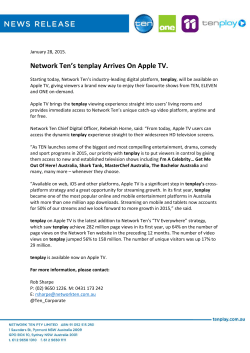
Microeconom´ıa II Maestr´ıa en Econom´ıa Problem Set II This
Microeconom´ıa II Maestr´ıa en Econom´ıa Problem Set II This problem set is due on Tuesday 28rd, April (during the midterm!) 1. A group of 20 economics students go out for a beer or two each Friday evening after class. There are two places that they use to hang out, Ramiro’s (R) and The Black Unicorn (B). Each of the students likes R far more than B because of its cozy atmosphere and its food. Indeed, each of the students dislikes the B because the music there is always too loud and they can hardly converse. An evening spent at R gives each student a payoff of 10 while an evening spent at B gives each student a payoff of −5. Yet, each of these students is eager to get some social recognition and enjoys been seen by her mates in a bar on Friday night. So, each student gets an extra payoff of 2 for each mate (out of the 20 students) to whom she is able to say hello in a bar (that is, each other student who is in the bar). One Friday evening each of the students decides whether to go to R or to B. They decide simultaneously and independently (there is a huge blackout that day which makes mobile phones completely useless). Use the Nash equilibrium solution concept to analyze whether it is reasonable an outcome in which many students decide to go to B. How many students at least would you predict that show up in B in a reasonable outcome (of course, from your game theorist’s perspective)? Argue formally and analytically. [15pts] 2. Apple sues Samsung over alleged imitation of its iPad. If Apple wins the appeal, then Samsung must pay π > 0 USD to Apple. Samsung’s lawyers estimate that the probability that Apple wins the appeal in court is λ ∈ [0, 1]. The cost of going to trial for these two firms are, respectively, ca > 0 and cs > 0. Parameter λ is given by a continuous random variable with density function f (λ). Samsung does know the actual value of λ (by means of its very capable lawyers) while Apple only knowns the density f (λ). Prior to going to court, both firms negotiate. Apple makes a γ > 0 USD “take it or leave it” offer to Samsung. If Samsung accepts, they it pays such amount γ to Apple. If Samsung rejects, then both firms go to trial in court. (a) Compute the pure-strategy PBNE for this game. [20pts] (b) How do the parameters π, ca > 0 y cs > 0 affect the outcome of the game? [10pts] 3. Two players are playing a game whose payoffs are determined by one of the two payoff matrices below: L R L R U 1, 1 1, 0 U 1, 0 0, 2 M 0, 2 1, 1 D 0, 3 1, 0 D 1, 0 0, 2 Player 1 (row player) knows the particular payoff matrix while player 2 (column player) only knows that the game can be either described by the first matrix, with probability p, or by the second 1 matrix, with probability 1 − p, where p ∈ (0, 1). (a) Provide an extensive-form game representation of this game. [10pts] (b) Solve this game, both in pure and in mixed strategies, using the solution concept that you consider most appropriate to this situation. [20pts] 4. Consider the modified Prisoner’s Dilemma game: D C P D 1, 1 4, 0 −1, 0 C 0, 4 3, 3 −1, 0 P 0, −1 0, −1 −2, −2 (a) Compute the Nash equilibria in pure strategies of this game. [5pts] (b) Suppose now that this game is indeed played twice, so that the players finally obtain the sum of the payoffs of the two stages. Consider the strategy that recommends each player: (i) Play C in the first stage; (ii) If your opponent played C in the first stage, play D in the second stage. Otherwise, play P in the second stage. Argue formally that this strategy constitutes a subgame perfect Nash equilibrium of the two-stage game. [20pts] 2
© Copyright 2025











